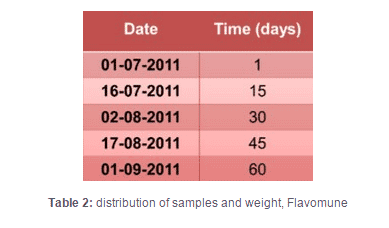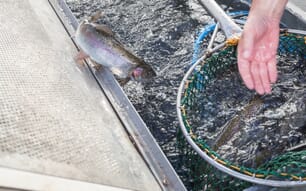Effective bath immunization systems may be very helpful to the salmon industry, particularly during the freshwater growth stages in which vaccination through injection is not possible. Protection of rainbow trout fry (Oncorhynchus mykiss) following bath vaccination with a bacterin, made with two Chilean pathogenic strains of F. psychrophilum, the bacterial pathogen causing Bacterial Cold Water Disease (BCWD), was investigated in productive conditions in a commercial farm in southern Chile. Production parameters such as weight, daily mortality percentage and cumulative mortality in approximately 20,000 rainbow trout of 3.9 g mean initial weight, were investigated.
The fishes were divided in 4 groups (two vaccinated groups and two control groups) over a period of 63 days equivalents to 460 degree days (average daily temperature of the farm 7.3± 0.4°C). At the end of the trial a positive 106% growth difference was obtained in the vaccinated group was 3.9 times less mortality in the vaccinated group compared to the control group was record. Moreover, there was a decrease in the number of treatments in the vaccinated group compared to the control group. In addition, serum antibody responses of rainbow trout were determined by enzyme–linked immunosorbent assay (ELISA) after 63 days post vaccination (DVP) with F. psychrophilum vaccine, the titer of the vaccinated group was 8 times higher than the control group. In this study, the bath vaccination against F. psychrophilum in rainbow trout was investigated in productive conditions.
Materials and methods
Test site
The trial was conducted during July–September 2011 (winter season), in a commercial fish farm, 30 kilometers to the East of Puerto Montt, X Region of Chile.
Fishes
Fishes of local stock rainbow trout of 4 g of average weight, spawning in late April were used for the realization of this experience. The fish were kept in conditions of fish farming with open water flow, with spring water gravimetrically, filtered and 100% day light photoperiod regime and was separated into groups according to selection protocols. The fish during the 63 DVP were separated in 5 m3 tanks with continuous flow, with water average temperature for this time of the year (July–September) of 7.5±0.5°C, with a concentration of dissolved oxygen (DO) of 9 mg/L, with manual feed delivery three times a day and with initial rearing density of 4 Kg/m3.
Experimental groups
Prior to the beginning of the experience, the pathogen–free status of the fish was confirmed by analysis for bacterial, parasitic and viral pathogens. Vaccination trial were conducted using a total of 20,000 of rainbow trout. Experiment was conducted in duplicate The four tanks for the experience were assigned as two vaccinated and two controls groups (number of fish and tanks identification are shown in table 1).
Vaccine
Flavomune® (Veterquímica S.A. Chile) inactivated bacterine against BCWD caused by F. psychrophilum, made with two virulents Chileans strains.
Vaccination
Half of the fish (10,000) were bath vaccination with Flavomune® diluted 1:10 in water for 1 min (Deep flushig) The other half of the fish (control groups) were sham–vaccinated with sterile TYES. (Figure. 1).
Sampling
During all the trial, temperature and water quality of the tanks were registered 4 times a day. In addition, the mean body weight of the groups was recorded every 15 days. All the mortality was daily collected, recorded and analyzed subjected by standard protocol of necropsy. The date of sampling and weights are shown in table 2. Blood samples was collected 63 DPV, ELISA was performed with serum samples to identify anti–F. psychrophilum antibodies using C11–HRP Kit (Aquatic Diagnostics Ltd UK.).
Results
Environmental parameters
During the trial, 460 UTA were accumulated and the temperature variation is shown in figure 2. It parallels that of from normal conditions typical of this geographical area.
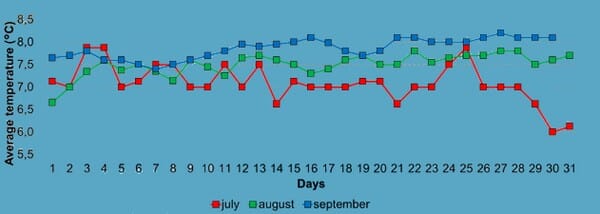
Growth
During all the assay, there were no differences in the tendency of growth between vaccinated and control groups both lines or profiles were in sharp increase, however vaccinated group growth rates were higher reaching equal–time growth 106% increase in weight compared to the control group (Figure 3).
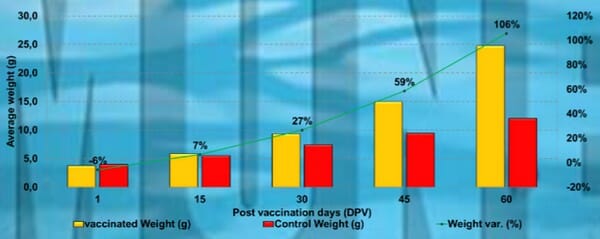
Mortality
The daily mortality analysis revealed the existence of three peaks of mortality (July 15; and August 2) associated with outbreaks of RTFS, and the last one (August 17) was associated with the selection criteria of the farm (figure 4). After 63 DPV the control group had 3.9 time more mortality, than the vaccinated group (12.96 v/s 3.23%) as seen in figure 5.
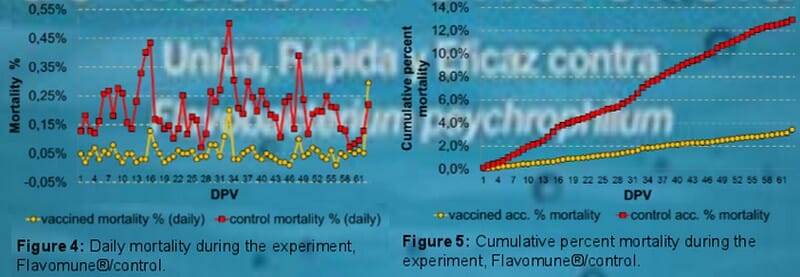
Serum antibody response
The results of titration of antibodies using ELISA was 8 times higher in the vaccinated group than control group after 460 UTA post vaccination (Figure 6).
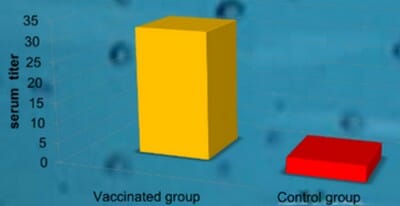
January 2014


